2014 spring game
Fuller
Question: Did you notice any appreciable difference in the Spring Game between the Borges offense and Nussmeier's? What are hoping to see by fall, and do you think they appeared to be heading in that direction?
Ace: Well...

I might not be very useful in this roundtable.
--------------------------
Brian: Well... it wasn't much different in person.
And the stuff they did show was the usual vanilla business that is designed to be as basic as possible, so I'm not sure there's a whole lot to glean. It looked a lot more compact than last year's offense, sure. All spring games look compact as the bells and whistles are stowed away for use on a two-point conversion in the bowl game after you're down one billion points.
Michigan did seem to have a dedication to the inside zone with a side of power, and the linemen seemed more focused on making sure the defensive tackle was good and beat up before trying to get to the second level. That led to a lot of runs that made it to the line of scrimmage (hooray!) and didn't get much further. And that's fine. You don't dig out of a hole as big as the one Michigan's in quickly. Michigan looks like it's going to be mostly an IZ team that mixes in power to keep opponents honest, and as long as they look like that through the nonconference season and don't start flipping people about all willy-nilly, that is the first step towards competence.
So that's what I think we'll see: a boring-ass offense that tries to keep errors to a minimum and punts a lot. People will complain about its predictability and simplicity and they'll be right. Michigan doesn't have much choice, unfortunately.
--------------------------
Seth: It's impossible to compare Borges's Michigan offense to anything, because Michigan's offense wasn't anything under Borges for more than a few games. The three things I was looking for were 1) personnel, 2) a concept, and 3) how well those things could complement each other.
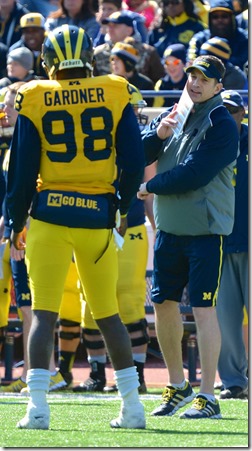 |
| If you flup this up, Doug, so help me Bo… |
Personnel was heavy, which was discouraging. For one Michigan has little in the way of tight ends. I didn't see anything from A.J. Williams, who was behind Heitzman, or Khalid Hill, who was behind Houma, and that was discouraging for hope of TE production before Butt's back. Houma is a fullback who lined up at the U only to motion back to fullback.
The operating theory on the OC hire was that Nussmeier at Bama was forced to use heavier formations than he wanted, however that compromise came down to 65% of snaps with three or more receivers:
| Team | Big | 2 WR | 3 WR | 4 WR |
|---|---|---|---|---|
| Bama (Sugar Bowl) | 3% | 31% | 58% | 7% |
| Michigan 2013 | 8% | 54% | 29% | 9% |
| Mich 2011-'12 | 7% | 41% | 43% | 9% |
| Mich 2008-'10 | 1% | 7% | 76% | 15% |
Eyeballing it, the spring game was closer to Michigan in 2013. If there was a difference it was more Ace as opposed to I-form, but that's less relevant because those second TEs were usually Houma and Kerridge, i.e. the fullbacks. There's a fear shared by every Michigan fan with a functional nervous system that the run-and-shoot-yourself-in-the-face offense under Borges was, despite protestations to the contrary, a mandate from the top. If Nussmeier compromises for Hoke more than he would for Saban, well, that would be insane. If that was all just a bunch of spring practice hooey, well, why are they spending spring practice on hooey when every countable hour is precious?
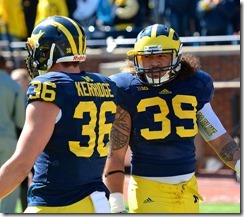 |
| Great scott Doc, this is too heavy. [Fuller] |
On the upside, there was a concept. The running was mostly zone, with some power mixed in only because you need to pull somebody to sell play-action. The passing game was a slight departure from Borges, who used a lot of 5-step patterns last year. These were 7-step patterns with an outlet, matching what we saw from Nussmeier at Alabama. The difference here can be overstated; Borges used lots of longer routes with Denard but went to the quicker stuff in 2013 because he couldn't get protection to last longer than that.
How do I feel about that? Well it fits the receivers' abilities. There's no Gallon to turn every 7-yard cushion into an easy 5 yards, but there's Canteen and the Funchise and lots of leapy things who can reel in a desperation heave. I have serious doubts the offensive line can hold up that long, but that's why there's an outlet. On the play I drew up it was Funchess running what appeared to be an option route; with Alabama it was usually an RB.
Zone is good. It's what Funk knows, it's easier to teach to young linemen, and we've already established his charges' total inability to pull correctly. My guess is the tight ends are in there because the OTs need help, though any time you have Heitzman/Williams/Houma in there instead of Chesson that's a talent downgrade.
I think the great hope for an offense that can finish in the top half of the conference is Gardner. I think Nussmeier is building an offense that is simple for everybody but him.
Extremely tentative starters/base alignment
Michigan's spring game happened. As per usual, there were things to generate text about, e.g. Gardner going 2/8 with two interceptions was tailor-made for lazy columnists hoping to get some play from a false QB controversy. Actual information-like-substance is somewhat less available, and even the things that are trackable are not to be trusted.
But this is Spring(!), when we take the selective, incomplete microcosm that they deign to show us and extrapolate from it the meaning of the universe. So I decided to go one step further, choosing a single play to make sweeping judgments about Michigan's new offense, the 2014 defense, and the future of human civilization that hangs in the balance.
The screencap above was from the first play that was broadcast, following Gardner's interception, a play with Morris and the twos, and a run with the 3rd stringers. Let's pick it apart.
Offense: Houma lined up as a U-back and then motioned into an offset fullback or H-back position on the strongside, strongly suggesting a run to that side. They instead ran a quick curl to Funchess. The line pass-blocked, with just Deveon Smith staying in to help them.
Defense: The good ol' 4-3 under. When the U-back went in motion, Clark spread out a bit to give him better leverage for a supposed one-on-one battle with the RT—if Houma hadn't gone in motion Clark was going to be responsible for him. The play is zone blitz; Ryan is coming, Wilson comes down to a robber zone, and Clark dropped into a zone on the backside. The corners and FS are playing a Cover 3. This is "aggressive" defense only because the DL's gaps are not in front of them, and there's five guys coming. The frontside "C" gap will have Jarrod Wilson, and all other gaps are covered. Or should be…
What happened: You'll note that Glasgow and Ryan ended up in the same "A" gap. That wasn't by design; Jack Miller was looking for the 3-tech or a WLB blitz, even after it was clear Godin was stunting and Bolden wasn't coming. With the OL pass-blocking, Glasgow abandoned his gap and ran unblocked to the quarterback.
This means Miller was right where Glasgow was supposed to go, but blocking nobody. Since that is Glasgow it was enough time to get a quick pass off, but if that was Mike Martin (or Willie Henry) it would have been a spectacular sack. Cole handled Beyer, and Bosch actually got a good sideways kick at Ryan that knocked him into Glasgow, giving Garner just enough time to get rid of the football. Since the CBs were in cov 3, Funchess was open underneath.
Also: RJS was playing SAM right, setting up to take on a fullback block in case of a run, then attacking when Houma didn't seem interested in contact. De'Veon Smith was set up to block him, but the play was over before we got to see how that went.
Lessons:
Offensive line: As expected, just as frustrating as it was last year. Miller didn't adjust to what was in front of him and that gave the nose tackle (of all people) a clear path to the quarterback despite good blocks. This play is a good example of how a good offensive line's communication and experience could bail them out against weird things, and vice versa. The more snaps Miller and Bosch see together, the better they'll be able to wordlessly shift their pass blocking assignments when they see a blitz is coming at the gap between them.
Routes: The frontside was a triangle with Canteen squatting between zones, Heitzman running the seam, and Houma leaking into the flat. The backside curl was an outlet pass. The frontside guys ran good routes—notice how Houma broke a bit more to the sideline when he saw Raymon Taylor had his zone. That widened Taylor and provided a spot between his zone and Wilson's for Canteen to settle into. Funchess's route was an outlet
How'd they get the 1st down: Experienced senior quarterback Devin Gardner recognized he needed to get the ball off, saw his outlet open underneath, and got it to Funchess with time to turn; big Funchess versus a cornerback means there's gonna be YAC.
How Borges is this? If that personnel seems not very different than what Michigan did a lot of last year, that's because it isn't a very big departure from it. Having guys like Houma and Heitzman in there as opposed to NORFLEET!, or just about any receiver, was a constant complaint with Borges. It's more defendable given that Darboh (and Drake Harris) were unavailable, so after Chesson you're getting into the Jones/Dukes/York/Dever receivers who aren't any more of a matchup problem than the catchy-blocky dudes.
This Ace 2TE thing was the base formation. Often both TEs would have their hands down to make a truly balanced formation. Heitzman and A.J. Williams traded off first team duties, and your second-team catchy-runny-blocky guys were Khalid Hill at Y-tight end and Joe Kerridge at U-back. Almost every running play was zone blocked. If Nussmeier's plan is to go back to his Washington offense it wasn't evident here; this was the same offense Bama ran in its bowl game (my UFR of that).
A run look to a side with Heitzman/Cole/Bosch is going to be even less scary than it was last year with at least Lewan in there, but I was still encouraged by the show. For one, these guys are all doing something their skill set suggests they should, with the exceptions of Heitzman's unknown quality as a receiver and De'Veon Smith's as a blocker. And for once they decided to do something catchy-blocky with Houma. Putting him in motion effectively changed his matchup from the WDE to the SAM, which isn't much of a change against Michigan's 4-3, but could be a mismatch if the SAM, as is often the case these days, was more of a safety-like object. And it also changed a balanced Ace formation into an offset I-form, which screams a run in that direction.
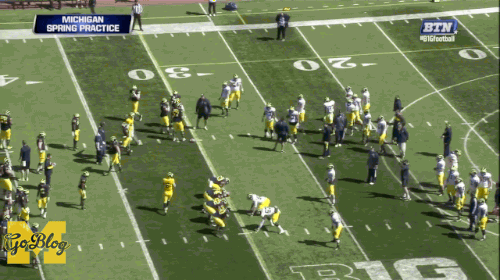
Unedited. Seriously.
My stomach gave a decidedly strong vote against my attending Saturday's Spring Game, so in lieu of watching from the press box I took in the Big Ten Network's telecast. This may have been less informative than skipping the Spring Game altogether.
Granted, it's difficult to make a glorified practice very interesting, even for Michigan die-hards. That said, the BTN totally missed the mark with their broadcast, failing the viewers in almost every regard to a comical extent.
Know Your Audience (Or: Show The Dang Play)
Let's take a look at some catching drills...
...or not, I guess.
Instead of showing or explaining the first hour of drill after drill, the network decided to show a whole lot of stuff like the video above: completely useless angles with a heavy dose of cutaways to coaches, current players the announcers happened to be discussing—even if they were just standing around—and former players on the sideline.* Click on those GIFs. It's as if an ADHD-stricken toddler hit buttons at random in the control booth.
Even when the cameras stayed focused on the field, it was obvious the BTN director had no idea what he was watching, which seems like it should be a prerequisite for directing a football telecast. If I had to boil down the BTN's effort into one video, it's this one:
In that same vein, check out this spectacular run by Justice Hayes.
The director also filled time with sideline interviews with Charles Woodson and Desmond Howard, two players who are instantly recognizable to any college football fan who's graduated elementary school. That didn't stop the BTN cameras from staying locked on the interviewees while actual football happened on the field.
We know what Michigan's last two Heisman winners look like, and yes, it's possible to play audio of an interview without actually showing video of the interview. This may come as a shock to some, namely whomever was in charge of this broadcast.
The actual scrimmage stuff wasn't much better, though they at least caught most of the plays on camera. Well, one camera, at least. Jourdan Lewis's impressive interception of Devin Gardner on the first play got one replay angle—a slow-motion version of the original broadcast angle, which failed to show anything in the secondary until Lewis caught the ball.
If you watched this for the purpose of learning about the team, you have my sympathy. If you watched this for any other purpose, you've made me very confused.
"People in charge of things are just in charge of them for no reason" tag deployed with vigor. Well done, BTN director.
-------------------
*The GIF at the top of the post features the back of Charles Woodson's head, if you can't tell, which is quite understandable.
[Hit THE JUMP for the only quote Doug Karsch needs to make his case for the vacant play-by-play spot, the quarterback "controversy" in one highlight package, and the end of the scrimmage that wasn't actually the end of the scrimmage.]

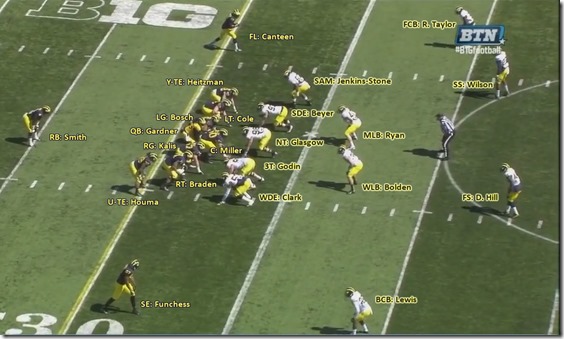
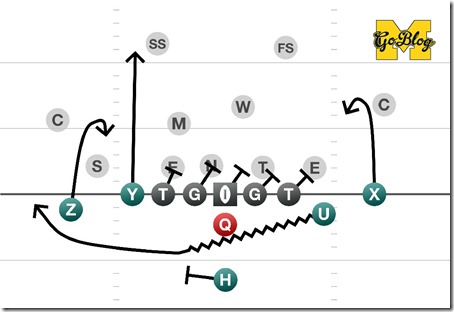
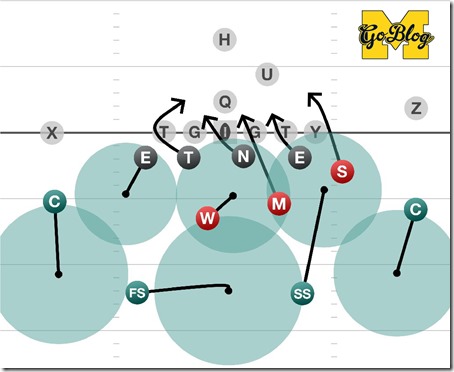
71